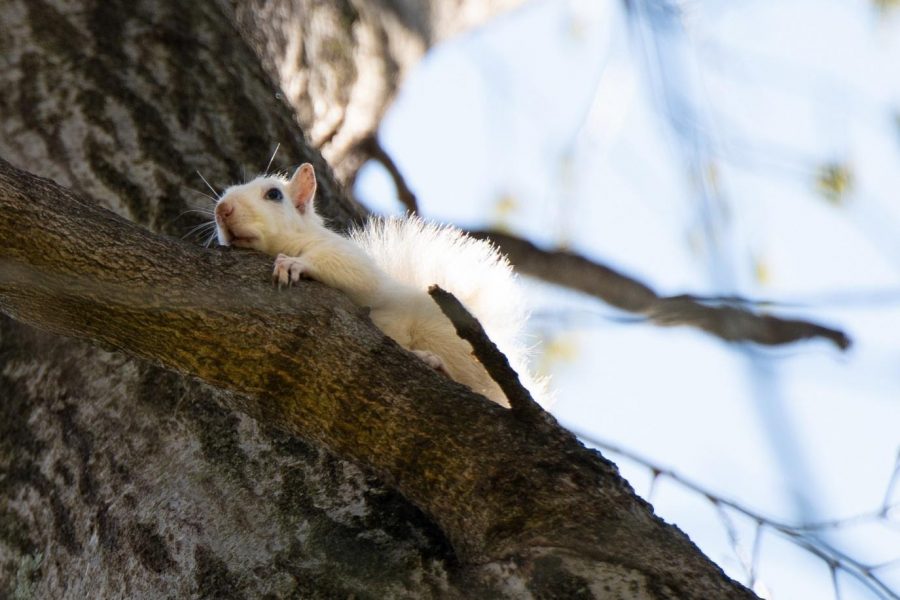Not quite a unicorn: The science of Bowling Green’s white squirrels
April 2, 2021
As any student of Western Kentucky University will say, it’s good luck to see a white squirrel.
So if anyone needs a dose of luck, they should walk by McLean Hall where it’s almost a guarantee to spot a fluffy white squirrel scouring the grass for food.
There are several common misconceptions about these community icons. Time to debunk the myths and clear the air.
First off, the squirrels did not come from a science experiment, but understanding why they are white will take a brief foray into science.
Myth: The squirrels here are albino …
In fact, these squirrels are just white versions of the Eastern Gray Squirrel, due to a condition called leucism. The biggest difference between leucism and albinism is that albino animals have red eyes because their cells are incapable of producing melanin, a protein responsible for pigment. Our squirrels have black eyes, and some even have a little bit of coloration in the fur if you look closely. Albinos can often have poor vision that is highly sensitive to sunlight because of the lack of pigment.
Jarrett Johnson, a WKU associate biology professor, said that in albinism, all the cells responsible for producing pigment are in the right place, but the melanin can not be produced because of a genetic mutation which disrupts one of several biochemical processes involved in creating pigment.
“But for leucistic animals,” Johnson said, “The problem is that melanin isn’t being deposited in the fur. So it’s still being produced, but for whatever reason–either during embryonic development or some other aspect of melanin mobilization–the melanin is not getting to the fur because of a mutation.”
A lot of times this error happens during embryonic development because a certain type of cell is emerging, known as neural crest cells, which go to different parts of the embryo and determine what the function of other cells will be, according to Johnson. Thus, these neural crest cells are able to transmit melanin production for cells in some places, like the eyes, but not in places where the fur cells are developing.
Little is known about the specific gene(s) responsible for leucism in squirrels, so research is needed in this area not only because of the public interest, but also because discovering how mutations play out during the embryonic stage of development could have implications for much more significant conditions.
Johnson has been approached before about doing research on the squirrels to see what might be causing the leucism.
“It’s something that might be interesting to take a shot at,” Johnson said. “I don’t have much experience catching squirrels,” he said. And though Johnson’s past research has focused on amphibians, he said that WKU does have the proper lab equipment to carry out an experiment, but no one has seriously considered the prospect yet. Mice and rats are much easier mammals to study in labs.
Myth: White squirrels are only found in Bowling Green, Ky. …
According to an unscientific mapping of white squirrels by ecologist Rob Nelson, they can be found in dozens of locations across the eastern U.S. This database was put together from photos sent in to Nelson.
Myth: The white squirrels around here are rare because they are easy prey …
These squirrels are actually fairly abundant, and they can be found in several areas around town.
As far as being hunted, it is likely that hawks have an easier time seeing these conspicuously-coated creatures in the forest, so it makes sense why they are more abundant in areas where there’s a lot of concrete that provides camouflage.
Another reason the squirrels may be abundant near urban landscapes is because humans are interested in them. When it comes to natural selection, the most fit animals are the ones that pass on genes through reproduction. It could be possible that humans are aiding in this selection process by protecting the white squirrels and favoring them over colored squirrels, Johnson said.
Myth: This is not that cool …
Louisville native Maria Julian said, “I don’t think they [white squirrels] are that unique since other towns have them.” She said she had seen them at Centre college before, so the novelty surrounding white squirrels had already gone by the time she got to WKU.
But for others, like Louisville freshman Maria Johnson, the white squirrel is very unique and cool. “I have never seen anything like them in my life,” she said. She said she uses the white squirrel filter on Snapchat sometimes.
In fact, many towns across the eastern U.S. would agree with the latter Maria. One such place is Marionville, Missouri, where the town gift shop is littered with white squirrel souvenirs, and it even has a white squirrel costume. There is something about a squirrel being white that people across America thoroughly enjoy.
Myth: The squirrels have only been around for 50 years or so …
According to the WKU Archives, a story published by the College Heights in Herald in 1939 is the first public record of white squirrels being on campus. So, these critters have been around for at least 80 years.
Over the years, several stories have been published by the Herald and the Bowling Green Daily News about this phenomenon. Humanity’s understanding of genetics has come a long way since the last story, a column for the Daily News by Geordon Howell, was published in 2006.
Why it matters
Much of our food today comes from genetically modified organisms, and we are fighting a pandemic with mRNA vaccine technology that originates from a deep knowledge of genetics. And going into the future, we will be editing out diseases from our children’s DNA using something called CRISPR gene editing, and people may be even adding traits into DNA that don’t belong.
Though white squirrels likely don’t hold any vast secret about genetics, some day in the future a human embryo with leucism or albinism may have their genes manipulated using information gleaned from experiments with white squirrels. That is the beginning of a long discussion on ethics, but it is also the end of this story.

























